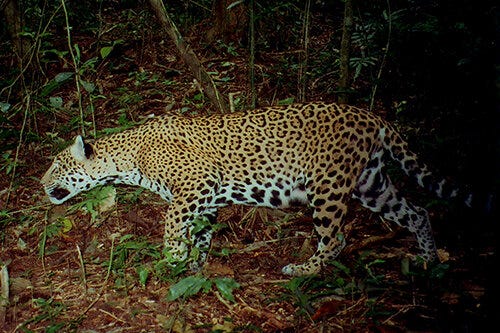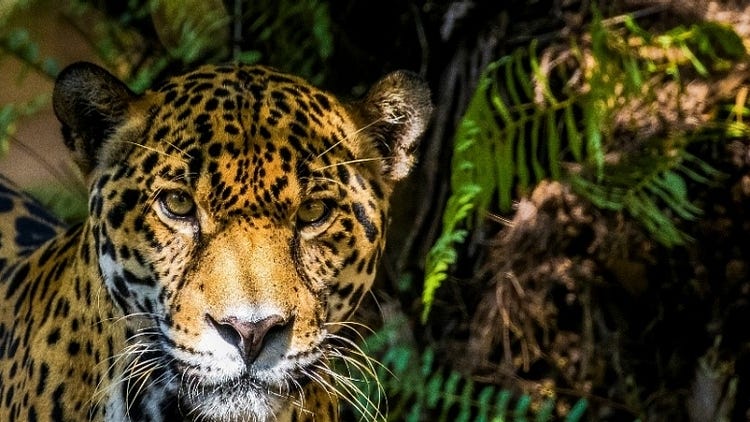International Jaguar Day on November 29th raises awareness about the increasing threats facing the jaguar and the critical conservation efforts needed to ensure its survival.

Photo credit: ©Midori Paxton, UNDP
The jaguar — the largest cat in the Americas and the third-largest in the world after lions and tigers — roams a vast stretch of land from northern Mexico to Argentina known as the Jaguar Corridor. But that corridor has dwindled to just 50% of its historic range. Ironically, one of the many symbolisms attributed to jaguars is protection, but today the fate of jaguars lies in humans being able to protect the habitat it roams in.
In 2018, a high-level forum brought together representatives from 14 jaguar range countries along with practitioners to kickoff region-wide cooperation for jaguar conservation. This led to the 2030 New York Statement. Following this, a Jaguar 2030 Conservation Roadmap for the Americas united various stakeholders around a shared vision to conserve jaguars. This strong regional coordination was reemphasized at the first high-level conference on Illegal Wildlife Trade in the Americas, held in Peru.
Regional collaboration is strengthened by the commitment to conservation at the national and local levels. In 2020, three jaguar-range countries — Belize, Ecuador, and Panama — joined the Global Wildlife Program (GWP), funded by the Global Environment Facility (GEF).
GWP projects look at jaguar conservation holistically addressing multiple threats to jaguars such as habitat loss and fragmentation, human-jaguar conflict, and the trafficking of jaguar parts. They each place value in science-led research and monitoring to support informed decision-making.

A jaguar in one of Belize’s tropical forests was taken with a camera trap. Credit: Antonio de la Torre
Belize: A jaguar monitoring system to help tackle habitat loss and fragmentation
Belize is securing and maintaining three functional, but threatened, biodiversity corridors, each with significant populations of jaguars. This landscape is considered critical to maintaining connectivity for jaguars in Mexico, Guatemala, and Honduras. The project executed by the Forest Department, Ministry of Fisheries, Forestry, the Environment, and Sustainable Development in partnership with the United Nations Development Program (UNDP) is expanding camera trapping to monitor jaguars and their prey. This data will be used to strengthen enforcement efforts and create management plans for vulnerable habitats.
At the local level, the project is also enabling landowners to participate in conservation practices as citizen scientists, such as contributors to the national camera trap network.
“A priority of our government is to strengthen implementation of key actions relating to the protection and reduction of pressures on cornerstone species such as the jaguar, which is endemic and native to this region and is embedded and woven into the cultural and economic fabric of Belize. This project will allow for the enabling environment and activities to meet these critical national objectives.”
Dr. Kenrick W. Williams, CEO, Ministry of Sustainable Development, Climate Change and Disaster Risk Management, Belize

Jaguar, Panama. Photo credit: © Eduardo Estrada, Yaguará Panamá Foundation
Panama: Engaging cattle ranchers to mitigate human-jaguar conflict
Panama is one of the most crucial migratory routes in the Western Hemisphere. The GWP project executed by the Ministry of Environment and the Yaguara Panama Foundation in partnership with UNEP aims to mitigate human-jaguar conflict in and around Chagres National Park–Darien National Park Complex. An innovative aspect of the project is to work with six cattle ranches in the project site to demonstrate cost-effective human-wildlife conflict (HWC) prevention measures and generate proof of concept of jaguar-livestock coexistence in productive landscapes.
This pioneering effort would enable the integration of jaguar data in three protected area management plans and support activities on HWC and connectivity management.
“What we do in Panama to reverse the critical situation of the species is crucial since the Isthmus of Panama is the natural land bridge that maintains connectivity between the large populations of jaguars across the American continent.”
Shirley Binder, National Director of Protected Areas and Biodiversity, Ministry of Environment, Panama

Camera trap photo of jaguars in the Cotacachi Cayapas National Park, Ecuador. Photo credit: Ministry of Environment, Ecuador
Ecuador: tackling threats to jaguar populations such as illegal wildlife trade
In the Ecuadorian Amazon, the project executed by the Ministry of Environment, Water and Ecological Transition and the Wildlife Conservation Society (WCS) in partnership with UNDP, is carrying out a jaguar census to inform local and national-level conservation actions to reduce threats over the jaguar.
The initiative will strengthen the capacity of law enforcement officials to detect, control, and dismantle trafficking in wildlife and it will facilitate inter-agency coordination by establishing a working group. To fill the gaps in data, the project will undertake research on wildlife crime (hunting, trafficking, and trade) related to jaguars and put together communication initiatives that increase awareness of the public on the importance of jaguar conservation.
These examples the importance of ensuring coordination, maintaining connectivity, and promoting coexistence. Together, these three components can help offer the protection the jaguar needs if it is to survive and thrive.

 Locations
Locations